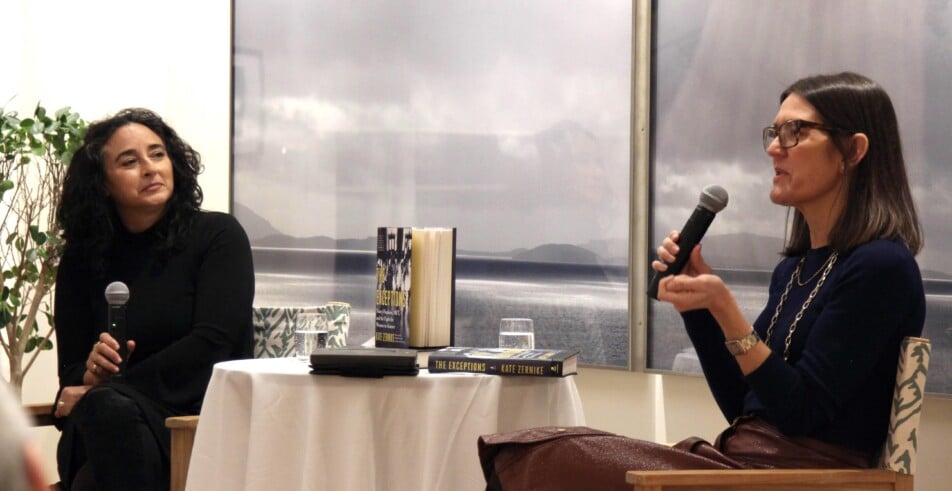The same year that the Beijing Women’s Conference gathered more than 17,000 participants in 1995, a small group of women scientists (along with three male colleagues) gathered as the Committee on the Status of Women Faculty in Science at MIT. They were charged with collecting data to demonstrate their experienced discrimination as women scientists working at MIT. The small committee may not have had nearly the same number of participants as the Beijing conference, but they did have numbers.
When creating their final report, these women scientists knew that their data was strong, but they needed to add their story to convince MIT to do something with this information. This is because the human brain is more responsive to storytelling. Studies show people are more likely to take action after hearing an emotionally engaging narrative.2 This is the power of Kate Zernike’s new book, The Exceptions: Nancy Hopkins, MIT, and the Fight for Women in Science, which details how women scientists got MIT to admit to discrimination against women scientists.
Vital Voices recently welcomed Kate Zernike to the Vital Voices Headquarters for Women’s Leadership for an intimate reading from The Exceptions, followed by a conversation with Soraya Chemaly. The Exceptions is its own data collection and storytelling project, as Zernike compiled the accounts of dozens of women directly involved in the MIT report and women who came before them in science.
While in The Exceptions Zernike skillfully details complex scientific concepts in an approachable manner, Zernike is not a scientist by trade. She is the journalist who broke the story of MIT’s admittance to gender discrimination to the world. Similar to a scientist, her extensive reporting career has been dedicated to the pursuit of knowledge and collection of data.
Where scientists tend to stay strictly in the realm of objective facts, Zernike adds a layer of nuance and perspective through storytelling. The fact that in 1991, a women scientist at MIT had 1,500 to 6,000 square feet less of space, a crucial resource in laboratories, than her male colleagues is disconcerting. Hearing the story behind this fact might motivate you to take action.
By 1991, Nancy Hopkins needed more space to do her scientific experiments as a tenured professor at MIT. She was consistently elbowed out of laboratories and storage spaces by men, both senior tenures and those with less experience than her. She went to the head of her department looking for a solution but was repeatedly told that she had just as much space as the men with whom she worked. The department head did not concede there was even a problem.
At the time, Hopkins would not have called what happened next a feminist protest, she just wanted to be able to do her work. Hopkins took out a tape measure and literally measured every inch of space in the department. For several weeks, she stayed late and conducted her measurements in the dark, so as not to call attention to herself. Her hypothesis: as a woman, she had less physical space for her work than her male colleagues. Her results: Hopkins had 1,500 square feet less than the average for male junior professors and 3,000 to 6,000 square feet less than men who were her fellow full professors.
Now that we have heard the story and want to do something, what is Zernike’s call to action for us? There are a hundred things we could do to combat discrimination against women in our daily lives. How do we start to combat the specific discrimination against women scientists?
Refer to specific women as brilliant and geniuses. And do it a lot.
Zernike learned this simple tactic from Nancy Hopkins herself. Nancy started calling all the women in her life brilliant and geniuses in conversations as much as possible when she picked up on how rarely we refer to women as such.
As with many stories that resonate, data backs Hopkin’s observation. For example, anyone can open the online tool Gendered Language in Teacher Reviews, type in either “brilliant” or “genius,” and get the results broken down by teaching department in seconds.
In keeping with Zernike’s call to action, I will end with this. My mother, Ann Maloney, is a brilliant scientist. She was the first person in her family to go to college, and she completed a master’s in biology. She worked in a neurophysiology lab for several years before turning to teaching various sciences at colleges and high schools. Her ability to engage otherwise apathetic students – both men and women – and foster careers in science is the making of a genius. I sent her a copy of Zernike’s book and look forward to discussing The Exceptions with her and learning more about her experience as a brilliant women scientist.
Find out where you can buy your copy of The Exceptions: Nancy Hopkins, MIT, and the Fight for Women in Science.
Written by Maggie Maloney, Senior Manager, Tech & Data at Vital Voices



